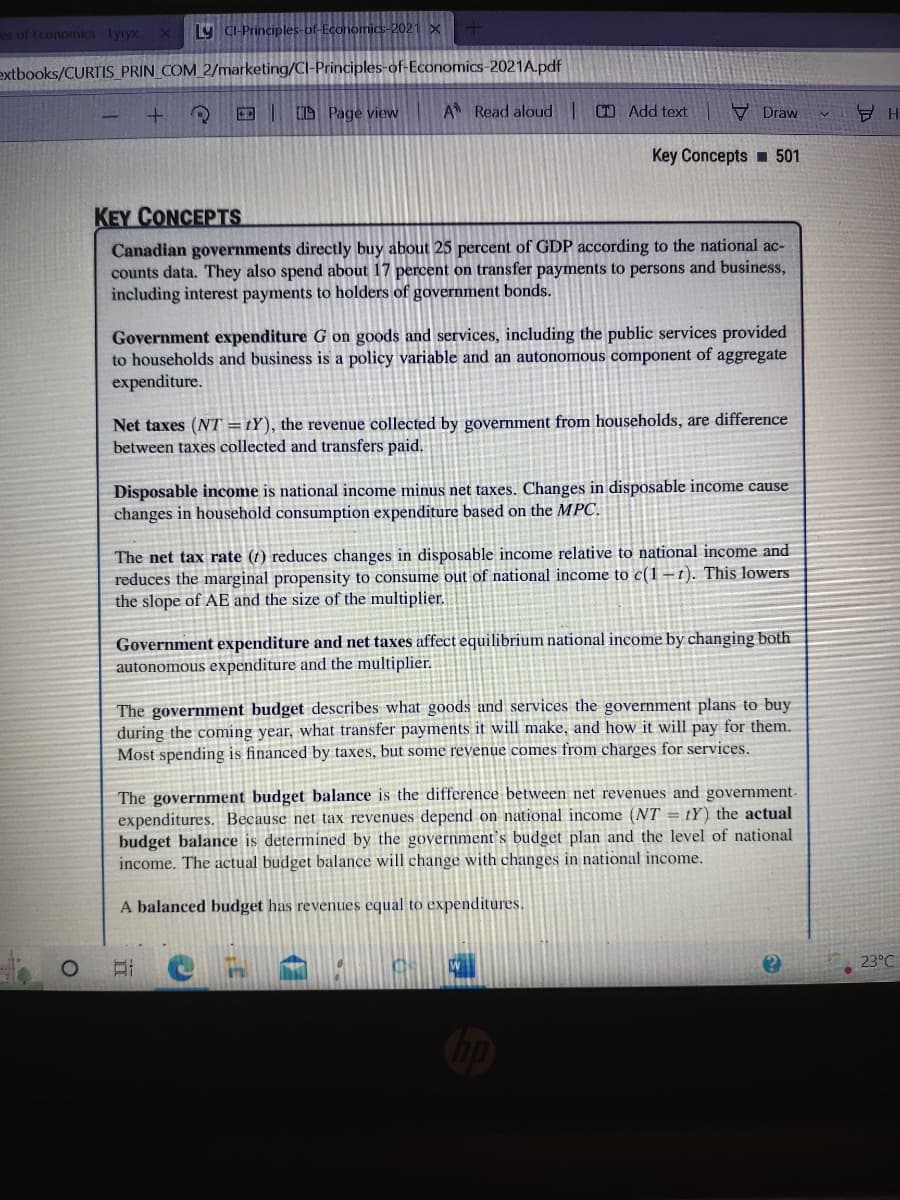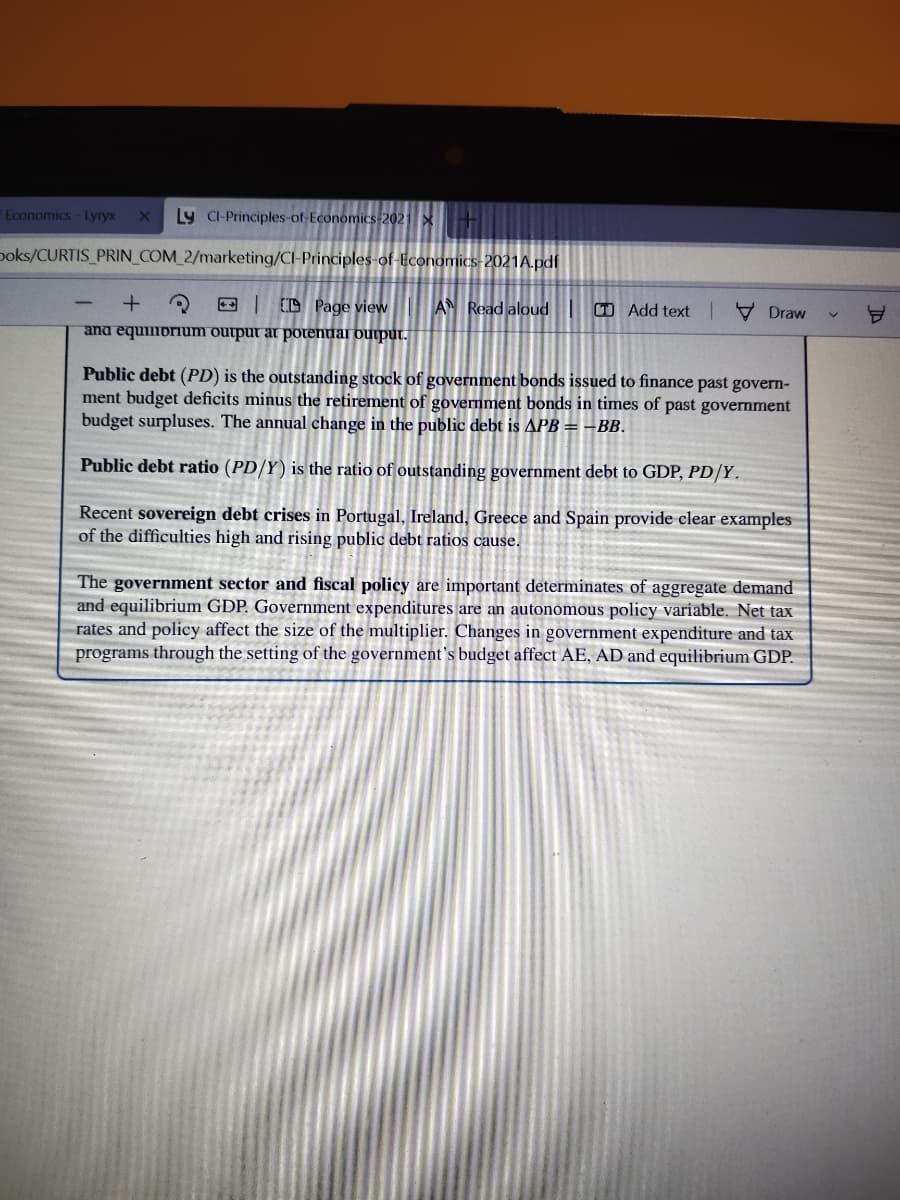KEY CONCEPTS Canadian governments directly buy about 25 percent of GDP according to the national ac- counts data. They also spend about 17 percent on transfer payments to persons and business, including interest payments to holders of government bonds. Government expenditure G on goods and services, including the public services provided to households and business is a policy variable and an autonomous component of aggregate expenditure. Net taxes (NT=tY), the revenue collected by government from households, are difference between taxes collected and transfers paid. Disposable income is national income minus net taxes. Changes in disposable income cause changes in household consumption expenditure based on the MPC. The net tax rate (1) reduces changes in disposable income relative to national income and reduces the marginal propensity to consume out of national income to c(1-1). This lowers the slope of AE and the size of the multiplier. Government expenditure and net taxes affect equilibrium national income by changing both autonomous expenditure and the multiplier. The government budget describes what goods and services the government plans to buy during the coming year, what transfer payments it will make, and how it will pay for them. Most spending is financed by taxes, but some revenue comes from charges for services. The government budget balance is the difference between net revenues and government- expenditures. Because net tax revenues depend on national income (NT=tY) the actual budget balance is determined by the government's budget plan and the level of national income. The actual budget balance will change with changes in national income. A balanced budget has revenues equal to expenditures. O II
KEY CONCEPTS Canadian governments directly buy about 25 percent of GDP according to the national ac- counts data. They also spend about 17 percent on transfer payments to persons and business, including interest payments to holders of government bonds. Government expenditure G on goods and services, including the public services provided to households and business is a policy variable and an autonomous component of aggregate expenditure. Net taxes (NT=tY), the revenue collected by government from households, are difference between taxes collected and transfers paid. Disposable income is national income minus net taxes. Changes in disposable income cause changes in household consumption expenditure based on the MPC. The net tax rate (1) reduces changes in disposable income relative to national income and reduces the marginal propensity to consume out of national income to c(1-1). This lowers the slope of AE and the size of the multiplier. Government expenditure and net taxes affect equilibrium national income by changing both autonomous expenditure and the multiplier. The government budget describes what goods and services the government plans to buy during the coming year, what transfer payments it will make, and how it will pay for them. Most spending is financed by taxes, but some revenue comes from charges for services. The government budget balance is the difference between net revenues and government- expenditures. Because net tax revenues depend on national income (NT=tY) the actual budget balance is determined by the government's budget plan and the level of national income. The actual budget balance will change with changes in national income. A balanced budget has revenues equal to expenditures. O II
Chapter13: Capital, Interest, Entrepreneurship, And Corporate Finance
Section: Chapter Questions
Problem 1.1P
Related questions
Question
Please provide a summary of these key points

Transcribed Image Text:es of Economics Lyryx X Ly CI-Principles-of-Economics-2021 x
extbooks/CURTIS PRIN_COM_2/marketing/Cl-Principles-of-Economics-2021A.pdf
+
?
Page view
A Read aloud Add text
Draw
Key Concepts 501
KEY CONCEPTS
Canadian governments directly buy about 25 percent of GDP according to the national ac-
counts data. They also spend about 17 percent on transfer payments to persons and business,
including interest payments to holders of government bonds.
Government expenditure G on goods and services, including the public services provided
to households and business is a policy variable and an autonomous component of aggregate
expenditure.
Net taxes (NT=tY), the revenue collected by government from households, are difference
between taxes collected and transfers paid.
Disposable income is national income minus net taxes. Changes in disposable income cause
changes in household consumption expenditure based on the MPC.
The net tax rate (1) reduces changes in disposable income relative to national income and
reduces the marginal propensity to consume out of national income to c(1-1). This lowers
the slope of AE and the size of the multiplier.
Government expenditure and net taxes affect equilibrium national income by changing both
autonomous expenditure and the multiplier.
The government budget describes what goods and services the government plans to buy.
during the coming year, what transfer payments it will make, and how it will pay for them.
Most spending is financed by taxes, but some revenue comes from charges for services.
The government budget balance is the difference between net revenues and government-
expenditures. Because net tax revenues depend on national income (NT=tY) the actual
budget balance is determined by the government's budget plan and the level of national
income. The actual budget balance will change with changes in national income.
A balanced budget has revenues equal to expenditures.
W
n
81
H
23°C

Transcribed Image Text:Economics - Lyryx x Ly Cl-Principles-of-Economics-2021 X
Doks/CURTIS PRIN_COM_2/marketing/CI-Principles-of-Economics-2021A.pdf
+
D9 Page view A Read aloud
Add textDraw
ana equilibrium output at potential output.
Public debt (PD) is the outstanding stock of government bonds issued to finance past govern-
ment budget deficits minus the retirement of government bonds in times of past government
budget surpluses. The annual change in the public debt is APB = −BB.
Public debt ratio (PD/Y) is the ratio of outstanding government debt to GDP, PD/Y.
Recent sovereign debt crises in Portugal, Ireland, Greece and Spain provide clear examples
of the difficulties high and rising public debt ratios cause.
The government sector and fiscal policy are important determinates of aggregate demand
and equilibrium GDP. Government expenditures are an autonomous policy variable. Net tax
rates and policy affect the size of the multiplier. Changes in government expenditure and tax
programs through the setting of the government's budget affect AE, AD and equilibrium GDP.
ㅂ
Expert Solution
This question has been solved!
Explore an expertly crafted, step-by-step solution for a thorough understanding of key concepts.
Step by step
Solved in 2 steps

Knowledge Booster
Learn more about
Need a deep-dive on the concept behind this application? Look no further. Learn more about this topic, economics and related others by exploring similar questions and additional content below.Recommended textbooks for you


Principles of Economics 2e
Economics
ISBN:
9781947172364
Author:
Steven A. Greenlaw; David Shapiro
Publisher:
OpenStax


Principles of Economics 2e
Economics
ISBN:
9781947172364
Author:
Steven A. Greenlaw; David Shapiro
Publisher:
OpenStax